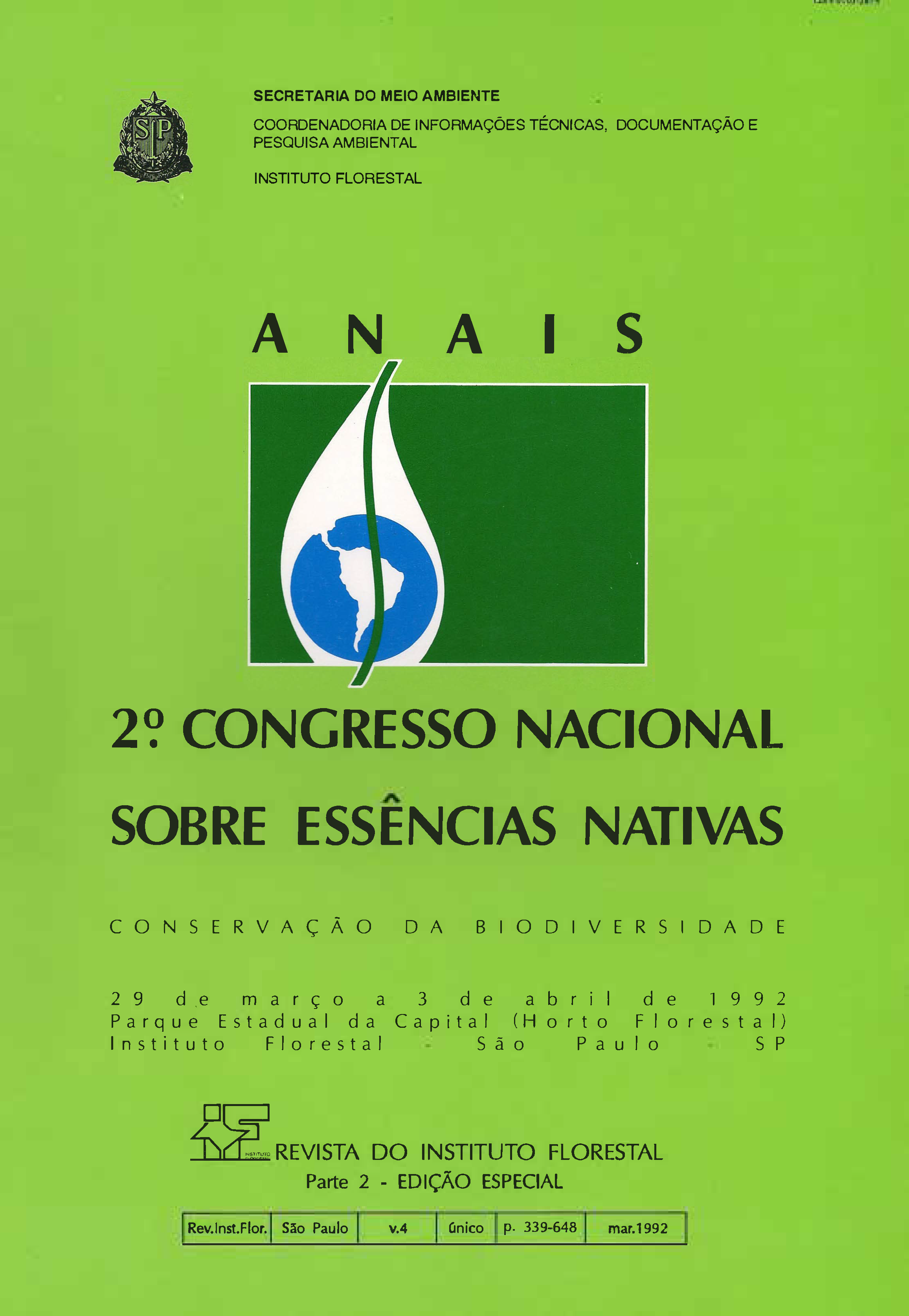INFLUÊNCIA DE FATORES QUÍMICOS DO SOLO SOBRE O DESENVOLVIMENTO DAS ESPÉCIES FLORESTAIS MAIS IMPORTANTES DO CERRADO DA RESERVA BIOLÓGICA DE MOJI-GUAÇU, SP
DOI:
https://doi.org/10.24278/2178-5031.199241346Keywords:
Savanna, edaphologyAbstract
lt was studied the influence of the soil chemical properties on formation of the savanna vegetation and its effects on the development of lhe most important native species. Along a transect line located in order to cover the physionomic aspectof the existing vegetation soil samples were collected on plots (1 O m x 20 m) where the species had been identified in the phytosociologycal survey. The soil samples were analysed for the following chemical properties: soluble phosphorus, organic matter, pH, exchangeable potassium, calcium and magnesium, soluble,boron,zinc manganese, bases content, cation exchange capacity, bases saturation and exchangeable aluminium. The vegetation development was measured throught mean height, mean diameter, basal area, cylindric volume and number of trees per hectare. The data obtained from the vegetation measurements and there from the soil properties were analysed for linearcorrelation. The soil chemical properties that most influenced on lhe vegetation development were: potassium, phosphorus, bases content, boron and zinc. The native species most influenced by the soil chemical factors were: Qualea grandiffora, Byrsonima verbascifolia, Vochysia tucanorum, Macha erium villosum, Kiel m e yera va riabilis, Anadenanthera falcata andAspidosperma tomentosum. The biometric variables that more correlated itself with the soil chemical properties were: mean height ant mean diameter.
Downloads
References
ALVIM , P. de T., 1954. Teoria sobre a formação dos campos cerrados. Revista Brasileira de Geografia. 16(4): 496-498.
BARROS, N . F. , 1979. Growth and foliar nutrient concentrations of Eucalyptus grandis in relation to spodosol properties in South Florida, Gainsville. 174 p. (Ph D, Thesis - U niversity of Florida).
BATISTA, E. A., 1982. Levantamentos fitossociológicos aplicados à vegetação de cerrado, utilizando-se de fotografias aéreas verticais. Piracicaba. 86 p.(Mestrado - Escola Superior de Agricultura "Luiz de Queiroz" / USP.)
EITEN , G. 1971 ., Habitat flora of Fazenda Campininha, São Paulo, Brasil. ln: S I M PÓSIO SOBRE O CERRADO. 1 . São Paulo, Anais. Coord. M .G . Ferri, Ed. da Universidade de São Paulo.
EMBRAPA, 1976. Relatório Técnico Anual do Centro de Pesquisa Agropecuária dos Cerrados. A região dos cerrados. Planaltina, DF. , p. 1 7.
GOODLAN D, R . , 1971 . Oligotrofismo e alum ínio no cerrado. ln: SIMPÓSIO SOBRE O CERRADO 3. Anais. São Paulo, Ed. U S P, p. 44-60.
GOODLAND, R. & POLLARD, R., 1973. The Brazilian cerrado vegetation: A fertility Gradient. Journal of Ecology. 61 (1 ) 21 9-224.
HARDY, F. , 1959. Supplementary report on the soils of experiment stations of Minas Gerais, Brasil. lnterAmerican lnstitute of agricultural Sciences, Turrialba. 31 (Report n Q 32-8).
LOPES, A. S., 1975. A survey of the fertility status of soils under "cerrado" vegetation in Brazil. Raleigh 1 38 p. (Thesis, M .S. - North Carolina State University, U .S.A.)
MALAVOLTA, E . ; SARRUGE, J. R. & BITTENCOURT, V. C. , 1976. Toxidez de alumínio e de manganês. ln: SIMPÓSIO SOBRE O CERRADO 4. Brasília. Bases para utilização agropecuária, São Paulo, Ed. USP,Belo Horizonte, Ed. Itatiaia, p. 275-301 .
RIZZINI , D. T., 1963. Análise florística das savanas centrais. A flora do cerrado. ln: SIMPÓSIO SOBRE O CERRADO. Anais. São Paulo. Coord. M.G. Ferri, Ed.USP, São Paulo. p. 1 25-1 77.
S.A.S. INSTITUTE. SAS user'sguide. SAS lnstitute lnc. Edition, Raleigh, North Carolina.
SILVA JUN OR, M. C. da. , 1984. Composição Florística, estrutura e parâmetro fitossociológico do cerrado e sua relação com o solo na Estação Florestal de Experimentação de Paraopeba, MG. Viçosa. 1 30 p. (Mestrado - Universidade Federal de Viçosa).















